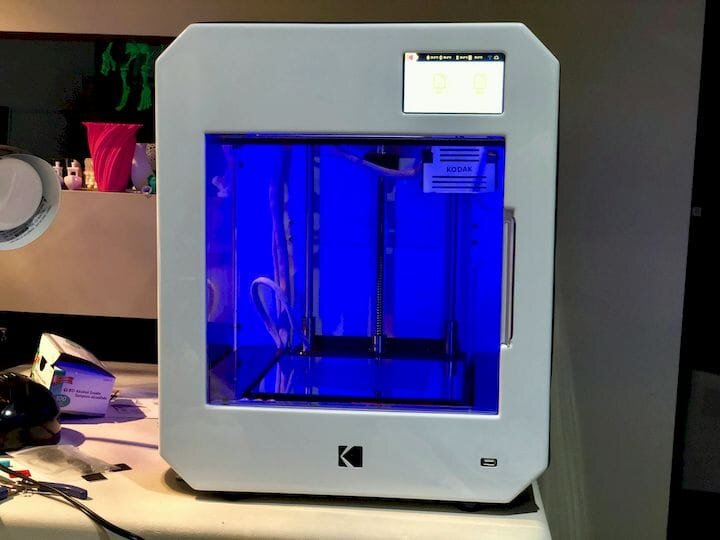Kodak announced a pair of new materials and some extra hardware for their powerful Portrait 3D printer.
The Kodak Portrait 3D printer is a favorite around our lab because it is able to very easily 3D print unusual materials. The company wisely focused on a professional-level device that caters to designers, engineers and architects, rather than a simple consumer machine.
Kodak 3D Printer Engineering Materials
That said, they are obligated to supply it with proper engineering materials. We’ve tested the device at length in our extensive four-part Kodak Portrait 3D printer review, where we found the machine to be terrific with a wide variety of materials, including HIPS, ABS, PLA, TPU, Nylon 6 & 12, PVA and PETG.
![Some of the many materials usable on the Kodak Portrait 3D Printer [Source: Fabbaloo]](https://fabbaloo.com/wp-content/uploads/2020/05/kodak-portrait-3D-printer-materials_img_5eb09057d61df.jpg)
Now they’ve added two unusual materials to their growing list of engineering options: acrylic and a nylon hybrid.
Kodak 3D Printing Acrylic Material
The acrylic is described as:
”Acrylic, a new filament designed by KODAK 3D Printing, combines polycarbonate properties which deliver on high rigidity and are light conductive, whilst also being easy to print. It is well-suited to optical applications as the material conducts light, allowing for the 3D printing of interesting prototypes or for pieces requiring high transparency. In addition,, the new Acrylic is low-friction and can withstand high temperatures. Due to its low friction coefficient, it works well with moveable parts.”
I have not previously seen acrylic used as a 3D print material, but from the description it sounds like it could find a home in many mechanical applications.
Kodak 3D Printing Hybrid Nylon Material
The other new material is called “Nylon 6/66/12”, which at first had me a bit confused. They already offer Nylon 6 and 12; were they offering Nylon 66 here? No, it seems they have concocted a new mixture that seems to be a combination of all three nylons.
This apparently develops powerful properties:
“Nylon 6/66/12 has also been introduced, as strong as traditional Nylon, but with greater flexibility. Unlike traditional Nylons, it is low warping and allows for better printing of fine details and overhangs.
Used in conjunction with the KODAK Portrait 3D Printer, which has been designed specifically to print high-temperature engineering materials, with a fully enclosed chamber and robust all-steel structure, it allows for less warp and more successful prints. Nylon 6/66/12 is particularly suitable for parts that need to be very strong with tensile resistance, or strong parts with fine details.”
That is also a very unusual material I have not seen elsewhere yet (although I am quite certain an observant reader will point out a source for me.)
Swappable Hot Ends
The other part of their announcement has to do with their unique extrusion system. The base model Portrait 3D printer includes dual extruders, but with a difference. While virtually all dual extrusion systems have identical hot ends, the standard Kodak Portrait 3D printer has two different hot ends. One is “all metal”, and is suitable for higher-temperature materials such as nylon, ABS and PETG, while the other hot end is designed with a PTFE tube and is most useful for “sticky” materials such as PVA, PLA and TPU.
Those materials tend to get stuck in the all-metal hot end, as I unfortunately discovered by accident during one frustrating day of testing. However, it was easily cleaned up and I learned an important lesson for using the Portrait 3D printer: use materials in their assigned hot end.
But now that seems to have changed as the company has introduced modular hot ends that can be swapped into the Portrait 3D printer to change the configuration. The new hardware includes an all-metal hot end and a PTFE hot end, just like the standard configuration. By the way, all of these hot ends are from E3D.
The extra hot ends allow you to switch to, say, a mode with two PTFE hot ends. That could allow you to 3D print PLA with PVA support material, for example. Or, you could configure the 3D printer with two all-metal hot ends for combining PETG and ABS, or perhaps using two different colors of HIPs during the same print job.
This is a very interesting option that could make the Kodak Portrait 3D printer more useful than it already is.


